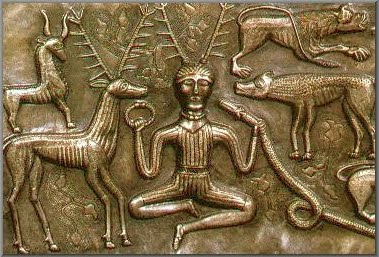Then Yajnavalkya said: "Verily, not for the sake of the husband, my dear, is the husband loved, but he is loved for the sake of the self which, in its true nature, is one with the Supreme Self.
"Verily, not for the sake of the wife, my dear, is the wife loved, but she is loved for the sake of the self.
"Verily, not for the sake of the sons, my dear, are the sons loved, hut they are loved for the sake of the self.
"Verily, not for the sake of wealth, my dear, is wealth loved, but it is loved for the sake of the self.
"Verily, not for the sake of the brahmin, my dear, is the brahmin loved, but he is loved for the sake of the self.
"Verily, not for the sake of the kshatriya, my dear, is the kshatriya loved, but he is loved for the sake of the self.
"Verily, not for the sake of the worlds, my dear, are the worlds loved, but they are loved for the sake of the self.
"Verily, not for the sake of the gods, my dear, are the gods loved, but they are loved for the sake of the self.
"Verily, not for the sake of the beings, my dear, are the beings loved, but they are loved for the sake of the self.
"Verily, not for the sake of the All, my dear, is the All loved, but it is loved for the sake of the self.
"Verily, my dear Maitreyi, it is the Self that should be realized—should be heard of, reflected on, and meditated upon. By the realization of the Self, my dear—through hearing, reflection, and meditation—all this is known." (Brihadaranyaka Upanishad, Part II, 4:4)
Not selfishness, exactly. Atman is not "ego." Love, but not love comes out of fear nor lack nor jealousy--rather, a love comes from a recognition of the nature of one's Self. I just explained it to a friend this way: love of Self is not selfishness, it is a recognition that that "other" you encounter is not not you (dble. negative intended, in case you were wondering). Understanding reincarnation, i.e., taking rebirth through a mama's sweet yoni, one can see how in some guise the possibility you may have been or perhaps shall be, that other.
So Buddha comes up to Brahma in a heaven realm, and notices that Brahma is surrounded by others sitting and listening as Brahma is teaching. So like, Buddha say, "Yo Brahma!! W's up? Why you still teaching if this be heaven?!"
At that moment, Buddha is taken in a reverie, and nigh faints. Brahma looks up from his thought, and ask the Buddha, "Why are you crying?" To which Buddha responds, "I saw all the lives I have lived, as every other, and I saw much suffering."
Point being, compassion and Self-interest are not disparate. To recognize others' suffering, by some degree of seperation or other, as one's own suffering (give or take however many cycles of lives lived) is one way to recognize
Atman, the Eternal Self that is the manifestation of
brahman (the Universal Divine Being, not to be mistaken with Lord Brahma, Creator aspect of the Trimurti) that is "in the world." Oh, and another point be: the journey of becoming don't end just 'cuz you get to heaven, 'cuz there's ages worth of dharma to be and do.




























